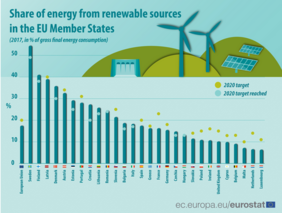Renewable energy statistics 2019 by Eurostat, the statistical office of the European Union, provides data on renewable energy sources in the EU between 2007-2017. During this period, an average increase of renewable energy production by 64% (average 5.1% per year) can be witnessed in the EU, which accounts for 17.5% of total consumed energy in the Union in 2017.
If we take the renewable sources share at country level in the EU, Sweden leads the way, producing 54.5% of energy from renewable sources, followed by Finland (41%), Latvia (39%), Denmark (36%) and Austria (32.5%). Renewables also have a prominent share in Estonia (29%), Portugal (28%) and Croatia (27%). By contrast, at the other end of the scale the weakest performance of renewables was registered in the United Kingdom (10.2 %), Cyprus (9.9 %), Belgium (9.1 %), Malta (7.2 %), the Netherlands (6.6 %) and Luxembourg (6.4 %). Wood and other solid biofuels hold first position among renewable energies in the EU-28, making 42.0 % of primary renewables production in 2017. Wind energy took second place (13.8 % of the total), for the first time overtaking hydropower (11.4 %). Although solar energy, biogas and liquid biofuels are characterized by relatively low levels of production, their expansion was rapid and they account for 6.4%, 7.4% and 6.7%, respectively, of the EU’s renewable energy produced in 2017. Ambient heat accounted for 5.0% of the total, geothermal energy for 3.0%, while renewable wastes reached 4.4%. Levels of tidal and ocean energy production were low, mainly represented in the United Kingdom and France.
In 2017, the share of energy from renewables in transport reached 7.6% (1.4% in 2004). Sweden with a share of 38.6% is the leader of the EU, followed by Finland (18.8%) and Austria (9.7%). Almost 20% of energy used for heating and cooling came from renewable sources in the EU-28. This is quite a marked increase from 10.4 % in 2004.
Electricity generated from renewable accounts for 30.7% of total gross electricity consumption in the EU-28. The amount of electricity generated from wind turbines was 3.5 times as high as it had been in 2007.In 2017 wind power was ahead of hydropower for the first time, which was characterized by a relatively equal amount of electricity generated at the level registered a decade earlier. Over this 10-year period solar power was characterized by rapid growth from 0.7% to 12.3%, taking third position and reaching a level of 119.5 TWh in 2017. The leaders of the market are Austria with 72.2% the electricity generated from renewable energy sources followed by Sweden (65.9%) and Denmark (60.4%). It is worth mentioning that these results are largely due to hydropower and solid biofuels.
By 2020, the EU member states have the challenging target of reaching a 20% share of the gross final energy consumption of the Union from renewable energy sources.
